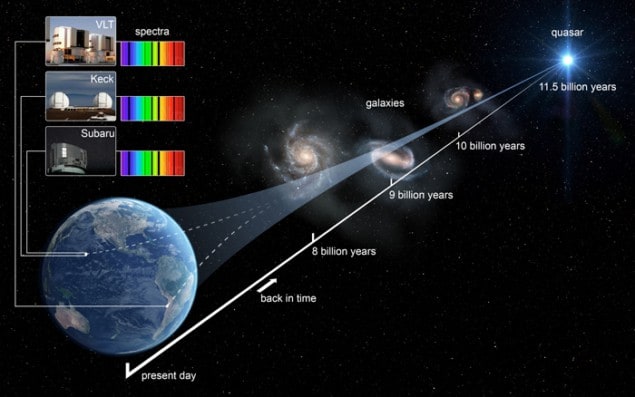
Astronomers studying the spectrum of a distant quasar have found that the ratio between the mass of the proton and that of the electron is constant – its value 12.4 billion years ago was identical to its value today – with a precision of 10–6. The study is crucial if physicists are to test theories that go beyond the Standard Model, as well as the nature of the mysterious dark energy that is accelerating the expansion of the universe. The results allude to the fact that dark energy – if it exists – has remained unchanged since the universe’s early days.
Using data gathered by the European Southern Observatory’s Very Large Telescope (VLT) in Chile, the team of astronomers, led by Julija Bagdonaite of VU University of Amsterdam, made use of light from a quasar – a distant galaxy powered by a hugely energetic and luminous supermassive black hole – shining through a “foreground” galaxy. In this case, the foreground galaxy itself existed 12.4 billion years ago, at a redshift of 4.22, when the universe was barely a 10th of its current age, while the quasar, at a redshift of 4.42, is even more distant. Molecular hydrogen in the foreground galaxy absorbs the quasar’s light, so that it is possible to detect specific energy transitions thanks to their recognizable spectral features. Should the value of the mass ratio “μ” be different, it would shift the levels of the energy transitions in the hydrogen.
Varying constants?
The mass of the proton – 1.67 × 10–27 kg – and the mass of the electron – 9.11 × 10–31 kg – are fundamental constants, along with other supposedly invariable properties such as Planck’s constant, the speed of light and the gravitational constant. The values of these constants cannot be derived from theory; as far as we can tell, they just are. However, some speculative theories that attempt to take physics beyond the Standard Model predict that these constants can change. The presence of scalar fields in the universe – fields with a single mathematical quantity that inhabit every point in space, such as dark energy’s quintessence or the Higgs field – may provide a means for this variance.
“Such scalar fields are likely to interact with fundamental particles such as electrons and quarks, and possibly affect how massive they appear,” says team member Michael Murphy of the Swinburne University of Technology in Melbourne, Australia. “It is possible that scalar fields, including a quintessence field, may cause variations in the fundamental constants, including μ.” The universe spent the first half of its life gradually transitioning from a matter (gravity)-dominated cosmos to a universe dominated by dark energy. Should μ be found to be different on either side of this transition, it would hint at the nature of dark energy. As well as measuring the proton–electron mass ratio, last year Murphy was also part of a team using this method and data from the VLT, Keck and Subaru observatories to search for variations in the fine-structure constant.
Methanol measurements
In 2013 Bagdonaite and co-author Wim Ubachs, also from VU Amsterdam, were part of a team that constrained any variation in μ to less than 10–7 in a galaxy that existed seven billion years ago, based on energy transitions in the spectra of methanol in interstellar clouds. This is an order of magnitude more precise than the new measurement, but it is much more difficult to make these measurements at higher redshifts. Rodger Thompson of the University of Arizona, who has made previous measurements of μ but who was not involved in the current research, says that the team’s result is very important as “it is the highest redshift limit on the variance of μ that exists”.
The results do not signal the end for unchanging constants. Indeed, Bagdonaite told physicsworld.com that “finding a variation at, say, the 10–9 level would be just as exciting and revealing, and I think that efforts to improve on the current limits will continue”.
The research is published in Physical Review Letters.



